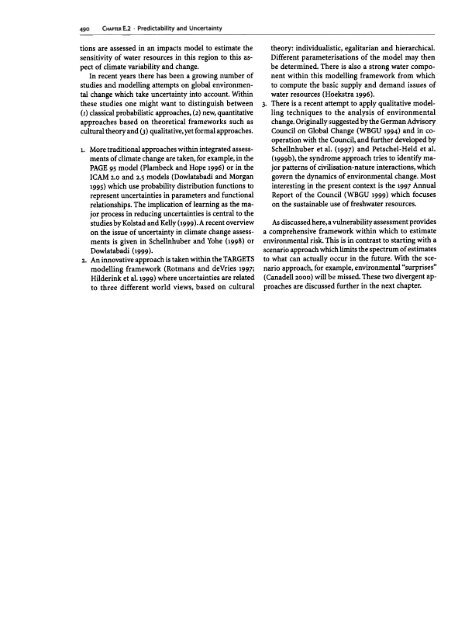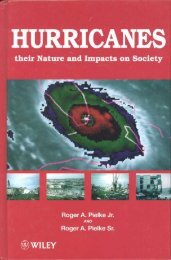How to evaluate vulnerability in changing environmental conditions
How to evaluate vulnerability in changing environmental conditions
How to evaluate vulnerability in changing environmental conditions
Create successful ePaper yourself
Turn your PDF publications into a flip-book with our unique Google optimized e-Paper software.
490<br />
CHAPTER E.2 .Predictability and Uncerta<strong>in</strong>ty<br />
tions are assessed <strong>in</strong> an impacts model <strong>to</strong> estimate the theory: <strong>in</strong>dividualistic, egalitarian and hierarchical.<br />
sensitivity of water resources <strong>in</strong> this region <strong>to</strong> this as- Different parameterisations of the model may then<br />
pect of climate variability and change.<br />
be determ<strong>in</strong>ed. There is also a strong water compo-<br />
In recent years there has been a grow<strong>in</strong>g number of nent with<strong>in</strong> this modell<strong>in</strong>g framework from which<br />
studies and modell<strong>in</strong>g attempts on global environmen- <strong>to</strong> compute the basic supply and demand issues of<br />
tal change which take uncerta<strong>in</strong>ty <strong>in</strong><strong>to</strong> account. With<strong>in</strong> water resources (Hoekstra 1996).<br />
these studies one might want <strong>to</strong> dist<strong>in</strong>guish between 3. There is a recent attempt <strong>to</strong> apply qualitative model-<br />
(1) classical probabilistic approaches, (2) new, quantitative l<strong>in</strong>g techniques <strong>to</strong> the analysis of <strong>environmental</strong><br />
approaches based on theoretical frameworks such as change. Orig<strong>in</strong>ally :,uggested by the German Advisory<br />
cultural theory and u) qualitative, yet formal approaches. Council on Global Change (WBGU 1994) and <strong>in</strong> cooperation<br />
with the Council, and further developed by<br />
1. More traditional approaches with<strong>in</strong> <strong>in</strong>tegrated assess- Schellnhuber et al. (1997) and Petschel-Held et al.<br />
ments of climate change are taken, for example, <strong>in</strong> the (1999b), the syndrome approach tries <strong>to</strong> identify ma-<br />
PAGE 95 model (Plambeck and Hope 1996) or <strong>in</strong> the jor patterns of civilisation-nature <strong>in</strong>teractions, which<br />
ICAM 2.0 and 2.5 models (Dowlatabadi and Morgan govern the dynamics of <strong>environmental</strong> change. Most<br />
1995) which use probability distribution functions <strong>to</strong> <strong>in</strong>terest<strong>in</strong>g <strong>in</strong> the present context is the 1997 Annual<br />
represent uncerta<strong>in</strong>ties <strong>in</strong> parameters and functional Report of the Council (WBGU 1999) which focuses<br />
relationships. The implication of learn<strong>in</strong>g as the major<br />
process <strong>in</strong> reduc<strong>in</strong>g uncerta<strong>in</strong>ties is central <strong>to</strong> the<br />
on the susta<strong>in</strong>able use of freshwater resources.<br />
studies by Kolstad and Kelly (1999).A recent overview As discussed here, a <strong>vulnerability</strong> assessment provides<br />
on the issue of uncerta<strong>in</strong>ty <strong>in</strong> climate change assess- a comprehensive framework with<strong>in</strong> which <strong>to</strong> estimate<br />
ments is given <strong>in</strong> Schellnhuber and Yohe (1998) or <strong>environmental</strong> risk. This is <strong>in</strong> contrast <strong>to</strong> start<strong>in</strong>g with a<br />
Dowlatabadi (1999).<br />
scenario approach which limits the spectrum of estimates<br />
2. An <strong>in</strong>novative approach is taken with<strong>in</strong> the TARGETS <strong>to</strong> what can actually occur <strong>in</strong> the future. With the sce-<br />
modell<strong>in</strong>g framework (Rotmans and de Vries 1997; nario approach, for example, <strong>environmental</strong> "surprises"<br />
Hilder<strong>in</strong>k et al.1999) where uncerta<strong>in</strong>ties are related (Canadell 2000) will b,e missed. These two divergent ap-<br />
<strong>to</strong> three different world views, based on cultural<br />
proaches are discussed further <strong>in</strong> the next chapter.














